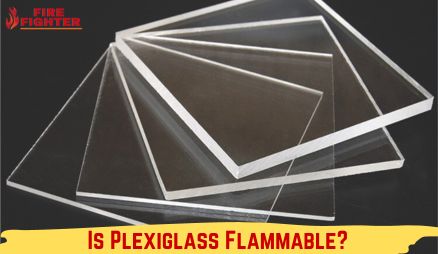Is Plexiglass Flammable? Burning Questions
When selecting materials for various applications, one key consideration is their flammability. Understanding the flammability properties of different materials can help ensure safety and mitigate potential risks.
This blog post will delve into the flammability aspect of a widely used material – plexiglass.
Stay tuned as we explore the topic in detail, providing valuable insights and information to help you make informed decisions.

Contents
What Is Plexiglass?
Plexiglass is a transparent plastic material that is commonly used as a lightweight and shatter-resistant alternative to glass. It is a brand name for acrylic glass, a thermoplastic type.
Plexiglass is made from polymethyl methacrylate (PMMA), a synthetic resin derived from petroleum.
It has similar optical properties to glass, including high transparency and excellent clarity, but it is significantly lighter and more impact-resistant.
Plexiglass is available in various thicknesses and can be easily cut, drilled, and shaped, making it a versatile material for various applications.
Is Plexiglass Flammable?
Plexiglass is not highly flammable, but it is indeed combustible. It has a flash point, the minimum temperature at which it can ignite, around 850 degrees Fahrenheit (454 degrees Celsius).
This means that plexiglass can catch fire under certain conditions, but it requires a relatively high temperature for it to do so.
When exposed to an open flame or intense heat, plexiglass will melt and eventually catch fire. However, it is important to note that plexiglass burns slower than other materials like wood or paper.
This is due to its chemical composition, which includes a polymethyl methacrylate polymer (PMMA). PMMA is a thermoplastic, meaning it can soften and melt when heated but does not release toxic fumes when burning.
Another factor that affects plexiglass’s flammability is its thickness. Thicker sheets of plexiglass are generally more resistant to burning than thinner ones.
Thinner sheets can quickly reach their flash point and ignite, while thicker sheets take longer to heat up, giving you more time to react and extinguish the fire.
Is Plexiglass Heat Resistant?
Plexiglass, or acrylic glass, has some heat resistance but is not as heat-resistant as certain materials like glass or metals. The exact heat resistance of plexiglass depends on the specific type and thickness of the acrylic sheet.
Suppose you are using plexiglass in applications where heat resistance is a concern. In that case, it is essential to consider the temperature conditions and choose the appropriate grade and thickness of the acrylic sheet.
Some specialty grades of plexiglass available offer enhanced heat resistance, such as heat-resistant or flame-retardant acrylics. These specialized options can withstand higher temperatures without deforming or melting.
What Is Plexiglass Used For
Plexiglass, or acrylic glass, has a wide range of applications due to its transparency, durability, and versatility. Here are some common uses of plexiglass:
Windows and skylights: Plexiglass is often used as a substitute for glass in windows and skylights, providing transparency while offering enhanced safety and impact resistance.
Protective barriers and shields: Plexiglass is widely used to create protective barriers and shields in various settings. For example, it is commonly used as sneeze guards in restaurants, checkout counters, and healthcare facilities to provide a physical barrier while maintaining visibility.
Signage and displays: Plexiglass is frequently used for signs, displays, and exhibition materials. Its optical clarity and ability to be easily shaped and engraved make it an ideal choice for showcasing information and products.
Aquariums and fish tanks: Plexiglass is a popular material for constructing aquariums and fish tanks due to its transparency, lightweight, and impact resistance. It allows for clear viewing of aquatic life while providing a safe and durable enclosure.
Protective covers and enclosures: Plexiglass creates protective covers for sensitive equipment, such as machinery displays or electronic devices. It offers a transparent shield that safeguards the equipment from dust, moisture, and physical damage.
Automotive applications: Plexiglass is used in various automotive applications, including windows, windshields, sunroofs, and headlight covers. It offers high impact resistance and helps reduce the vehicle’s weight compared to traditional glass.
Furniture and home decor: Plexiglass is employed in the design of furniture and home decor items such as tables, chairs, shelves, and decorative panels. It can add a modern and sleek aesthetic while maintaining functionality.
Art and crafts: Plexiglass is popular among artists and craft enthusiasts for creating sculptures, jewelry, picture frames, and other creative projects. Its versatility allows for cutting, shaping, and molding into various forms.
Is Polycarbonate Flammable?
Polycarbonate is a thermoplastic polymer that is derived from bisphenol A (BPA) and phosgene. It possesses a high ignition temperature, making it inherently flame-resistant. This means that polycarbonate does not readily catch fire or propagate flames.
Polycarbonate has a UL 94 flammability rating, a standard test method for evaluating the flammability of plastic materials.
Under this rating, polycarbonate is classified as self-extinguishing, meaning it will not continue to burn once the ignition source is removed. This characteristic is crucial in applications where fire safety is a concern.
Does Plexiglass Melt Or Burn?
Plexiglass, or acrylic glass, can melt when exposed to high temperatures. The specific temperature at which it melts depends on the type and thickness of the plexiglass sheet.
Generally, plexiglass softens and deforms around 160 to 190 degrees Celsius (320 to 374 degrees Fahrenheit). As the temperature increases, it can eventually melt, losing its shape and structure.
When plexiglass melts, it typically forms a viscous liquid rather than catching fire or burning like other materials.
However, it is important to note that excessive heat can cause plexiglass to release flammable vapors. These vapors can ignite if exposed to an open flame or other ignition sources.
At What Temperature Does Plexiglass Burn?
Plexiglass, or acrylic glass, does not have a specific temperature at which it burns like some combustible materials.
Instead, it is considered a thermoplastic material, which means it softens and melts when exposed to high temperatures rather than undergoing a combustion reaction.
Plexiglass begins to soften and deform around 160 to 190 degrees Celsius (320 to 374 degrees Fahrenheit).
As the temperature increases, it can melt, lose shape, and eventually degrade. However, plexiglass does not sustain a flame or support combustion alone.
Is Burning Plexiglass Toxic
Plexiglass is made from polymethyl methacrylate (PMMA), a synthetic resin derived from petroleum. Plexiglass can release harmful gases and fumes when exposed to high temperatures, such as burning.
The combustion process breaks down the polymer chains in PMMA, leading to the release of toxic substances.
One of the major concerns when burning Plexiglass is the emission of hydrogen cyanide gas. Hydrogen cyanide is a highly toxic compound with severe health effects when inhaled.
It can cause symptoms ranging from dizziness and headache to respiratory distress and even death in extreme cases.
It is important to note that the toxicity of hydrogen cyanide is not only limited to Plexiglass but also applies to other materials that contain cyanide compounds.
Conclusion
Plexiglass, or acrylic glass, is not considered a highly flammable material. It does not sustain a flame or support combustion on its own.
However, it is important to note that plexiglass can release flammable vapors when exposed to high temperatures.
These vapors can ignite if they come into contact with an open flame or other ignition sources.
Therefore, while plexiglass is not highly flammable, it is still necessary to handle and use it cautiously, avoiding exposure to excessive heat sources and open flames to prevent any potential fire hazards.

Hi, I m Aaron Smith, a firefighter, and creator of Firefighterline.com, a website that provides top-notch training courses for firefighting organizations. After completing my studies, I quickly rose through the fire service ranks, eventually becoming Captain at one of the busiest fire departments in the state.

